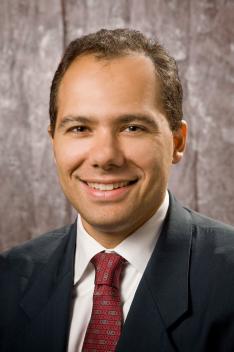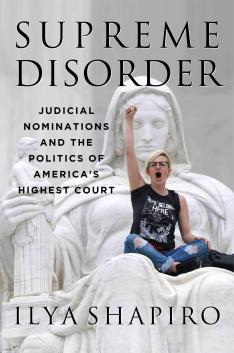Shapiro suggests that political fights over Supreme Court nominees are inevitable so long as the court plays such a large role in the expansion of federal power. Shapiro tackles the fundamentals of the court to propose reforms aimed at limiting the court’s role in expanding federal power and therefore depoliticizing its justices.
The author: Ilya Shapiro is the director of the Robert A. Levy Center for Constitutional Studies at the Cato Institute. Before joining Cato, he was a special assistant/adviser to the Multi-National Force in Iraq on rule-of-law issues and practiced at Patton Boggs and Cleary Gottlieb. Shapiro is the co-author of Religious Liberties for Corporations? Hobby Lobby, the Affordable Care Act, and the Constitution (2014), and editor of 11 volumes of the Cato Supreme Court Review (2008-18). He has contributed to a variety of academic, popular, and professional publications, and regularly provides commentary for various media outlets. Before entering private practice, Shapiro clerked for Judge E. Grady Jolly of the U.S. Court of Appeals for the Fifth Circuit. He holds an MSc from the London School of Economics, and a JD from the University of Chicago Law School.Opening lines: When Justice Charles Evans Whittaker retired in March 1962 after just over five years on the Supreme Court, John F. Kennedy had his first opportunity to shape the high court. The youthful president selected a man of his own generation, Byron White. White had met JFK in England while on a Rhodes Scholarship—after having been runner-up for the Heisman Trophy and spending a year as the highest-paid player in the NFL—and the two became fast friends.
White was a vigorous fourty-five and serving as the deputy attorney general under Robert F. Kennedy. Kennedy formally nominated him on April 3, 1962. Eight days later, White had his confirmation hearing, a quick ninety minutes including introductions and supporting testimony from various bar association officials (during which the nominee doodled on his notepad). What questioning there was largely concerned the nominee’s storied football career; “Whizzer” White was surely the last person to play a professional sport while attending Yale Law School. The judiciary committee unanimously approved him, and later that day so did the Senate as a whole, on a voice vote.
My, how times have changed.
The battle to confirm Brett Kavanaugh showed that the Supreme Court is now part of the same toxic cloud that envelops all of the nation’s public discourse. Ironically, Kavanaugh was nominated in part because he was thought to be a safe pick, with a long public career that had been vetted numerous times. He was firmly part of the legal establishment, specifically its conservative mainstream, and had displayed a political caginess that made some on the right worry that he would be too much like John Roberts rather than Antonin Scalia or Clarence Thomas. As it turned out, of course, 11th-hour sexual assault allegations transformed what was already a contentious process into a partisan Rorschach test. All told, Kavanaugh faced a smear campaign unlike any seen since Robert Bork. …
Confirmation processes weren’t always like this. The Senate didn’t even hold public hearings on Supreme Court nominations until 1916, a tumultuous year that witnessed the first Jewish nominee and the resignation of a justice to run against a sitting president. It wouldn’t be until 1938 that a nominee testified at his own hearing. In 1962, the part of Byron White’s hearing where the nominee himself testified lasted less than fifteen minutes.
But while the confirmation process may not have always been the spectacle it is today, nominations to the highest court were often contentious political struggles. For the republic’s first century, confirmation battles, including withdrawn and postponed nominations, or those upon which the Senate failed to act—Merrick Garland was by no means unprecedented—were a fairly regular occurrence…
Then of course there’s Merrick Garland, the first nomination the Senate allowed to expire since 1881—but then the last time a Senate controlled by the party opposite to the president confirmed a nominee to a vacancy arising in a presidential election year was 1888. As we now know, Senate Majority Leader Mitch McConnell’s gamble worked: not only did it not hurt vulnerable senators running for reelection, but the vacancy held Republicans together and provided the margin for Donald Trump in key states. Trump rewarded his electoral coalition with the nomination of Neil Gorsuch, who was confirmed only after the Senate decided, on a party-line vote, to exercise the “nuclear option” and remove filibusters.
Opportunities for obstruction have continued—pushed down to blue slips, cloture votes, and other arcane parliamentary procedures—even as control of the Senate remains by far the most important aspect of the whole endeavor. The elimination of the filibuster for Supreme Court nominees was the natural culmination of a tit-for-tat escalation by both parties.
More significantly, by filibustering Gorsuch, Democrats destroyed their leverage over more consequential vacancies. Moderate Republican senators wouldn’t have gone for a “nuclear option” to seat Kavanaugh in place of Anthony Kennedy, but they didn’t face that dilemma. And they won’t face it if President Trump gets the chance to replace Justices Ruth Bader Ginsburg or Stephen Breyer, which would be an even bigger shift.
Given the battles we saw over Gorsuch and Kavanaugh, too many people now think of the justices in partisan terms. That’s too bad, but not a surprise when contrasting methods of constitutional and statutory interpretation now largely track identification with parties that are more ideologically sorted than ever…
Pundits always argue that judicial nominations should be among voters’ primary considerations when choosing a president. Well, the Supreme Court’s future truly did hang in the balance in 2016. The election was so consequential in part because people knew that its winner would have the first chance in more than twenty-five years to shift the Court’s ideological balance. Indeed, the Court now stands starkly split 5–4 on many issues: campaign finance, the Second Amendment, religious liberty, and regulatory power, to name a few. If Hillary Clinton had been able to appoint a progressive jurist—even a “moderate” one—these policy areas would be headed in a substantially different direction.


